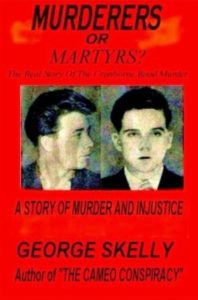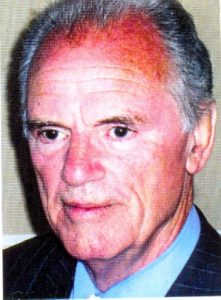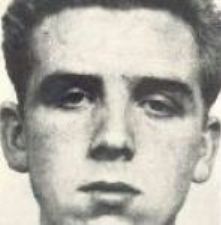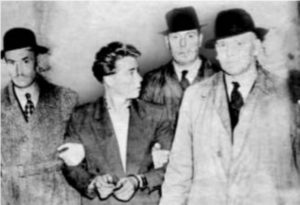CRANBORNE ROAD MURDER by george skelly, ba (hons), dip.lit (oxon)
On August 19th 1951, recently widowed Beatrice Alice Rimmer was attacked immediately upon entering her terraced, bay-windowed house in the then genteel Cranborne Road, opposite Sefton General Hospital on Smithdown Road.
With three murders in the space of two years however, the area was rapidly losing its genteel image and becoming known as “Murder Mile”. One had taken place a short distance away in Underley Street when the perpetrator, cornered in a Toxteth pub, had shot himself dead. Then in the very next road to the Rimmer home, the infamous Cameo murders had occurred two years earlier.
Det. Supt Hector Taylor, acting head of the CID, took charge of the investigation, which involved routine police measures in murder cases. e.g. searching drains etc for the murder weapon (which was never found).
Taylor and Det. Chief Inspector Jimmy Morris, after going through the victim’s possessions and correspondence, suspected her son Thomas, her only child and former constable, who had recently resigned from Liverpool City Police.
Because he had discovered her body at 7.15 on the 20th August, Thomas, who lived in Toxteth’s Madryn Street, was interrogated as to why he visited his mother so quickly after her Sunday visit to him the previous day. They also had police and Home Office forensic reports that nobody had climbed through the broken back kitchen window, which was assumed to have been the killer’s access, and which he said he had enlarged to gain access himself.
The detectives were quite pleased that they had a suspect. But when they informed Det. Chief Supt. Balmer of this on his return from holiday on 2nd September, he told them to discount Thomas Rimmer, who had re-applied to join the city force.
Balmer, who had an army of informers, including the city’s prostitutes, was soon at Walton prison, following information received from a local villain on remand and expecting a lighter sentence in return. This led to him interviewing a young housebreaker named McLoughlin who was awaiting transfer to Borstal for robbing his own Aunt’s house in Cranborne Road. This 19 year-old with an appalling criminal record told Balmer that he and a man nicknamed “Ginger” who was sleeping rough, had planned to rob the Rimmer home. But he had not been able to take part through being arrested for his “Aunt’s job.” But, said McLoughlin, “Ginger” had said he wouldn’t hesitate to use violence if Mrs Rimmer resisted.
Balmer believed this story so much so that he enlisted his journalist friends in the Liverpool Press Club to publish news of a police manhunt for “Ginger, together with his full description and his known haunts. This was also circulated nationally in the Police Gazette. But “Ginger”, whose “real” full name was known, was never found.
Meanwhile police located a young Manchester woman McLoughlin had mentioned who, like him, frequented the city’s all-night cafes. She was already wanted for skipping police bail after being involved in a Berry Street shop break-in with two Liverpool thieves. June Bury was located in Manchester, her native city. During her questioning she mentioned two Mancunians named Devlin and Burns, with whom she had been associating in Liverpool in early August. Further enquiries revealed that these two were on the run – one as a Borstal absconder, the other after being bailed on a robbery charge. Both men were house and shop-breakers.
At the Rimmer home, although the victim, found lying in the hallway, had sustained horrendous injuries, including 15 separate wounds to the head, strangely, nothing had been stolen nor anything even disturbed. Nor were any of the accused fingerprints found.
21 year-old Alfred Burns and 22 year-old Edward Devlin were soon roped in. Whilst admitting they had been associating with the girls in Liverpool up to August the 8th, both vehemently denied any involvement in the murder.
But Balmer, after 11 further visits to him in Walton, was armed with a statement from McLoughlin, who now named them both as the men he had planned the “Rimmer job” with. June Bury and her friend, a 17-year-old Liverpool girl, Marie Milne, also made statements referring to the men planning the Rimmer robbery in the Continental all-night café and on a train journey to Manchester.
The trial opened on the 11th February 1952, where Burns counsel, Sir Noel Goldie QC, surprised the court by revealing that the two men had an alibi: they could not have been the murderers because they were breaking into a Manchester clothing warehouse on the night of 19th August! Moreover they produced several witnesses, including the warehouse owner. But the jury, some of whom had read the nightly Committal proceedings in the Liverpool Echo, took only 75 minutes to find them guilty.
At the Court of Criminal Appeal, Lord Goddard refused to hear new evidence that June Bury had told three girls another boyfriend of hers was responsible for the murder.
An Inquiry was then held in secret at the city’s Municipal Annexe, which found that no miscarriage of justice had taken place. Denied reprieves. Devlin and Burns were hanged side by side at Walton prison on April 25th.
That is the official story. But during 12 years of research I uncovered an abundance of new evidence, including undisclosed statements, which I believe points to the men’s innocence. The real story will therefore be told in my book, Murderers Or Martyrs to be published by the Waterside Press in early 2012.
George Skelly, BA (Hons), Dip.Lit (Oxon)






